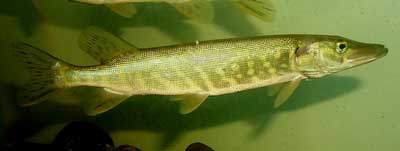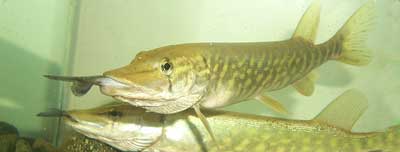Invasive Pike in Southcentral Alaska
Lake Stocking in Jeopardy
The Department stocks lakes to help meet public demand for fishing opportunity. Every year, the Department receives more requests for stocking than there are fish available. Hatchery fish help conserve wild stocks by spreading the fishing effort and harvest onto the stocked fish. Lake fishing is fun for all ages and skills, is inexpensive, and a stocked lake can usually be found nearby. In fact, the stocked lake fisheries are so popular that they account for almost 80% of the rainbow trout harvested statewide.
Among other things, lakes chosen for stocking must have no (or few) wild fish, be capable of supporting fish, and have guaranteed public access. Such lakes may get rainbow trout, Arctic char, landlocked salmon, Arctic grayling, or a combination of fish species. Before the spread of illegally-stocked northern pike, the Department could stock both "catchable-sized" fish (about 8 inches long) and "fingerling-sized" fish (about 2 -3 inches long).
The state's hatcheries do not have enough room to produce all catchable-sized fish, and catchables may cost as much as 20 times more than fingerlings. Larger numbers of fingerlings are often stocked in rural lakes, which usually have more plankton and insects for the fish to eat. Therefore, fingerlings quickly grow to a catchable size. Using fingerlings is cost effective because the young fish take advantage of the readily-available food in the lakes rather than food purchased through the hatchery.
Unfortunately, both catchable-sized fish and fingerlings are easy prey for pike. The Department cannot afford to feed hatchery-produced fish to pike. Once pike are found in a Southcentral Alaska stocked lake, the Department may decide to stop stocking the lake while evaluating the situation. If a lake is no longer stocked because of pike, that is one less opportunity for anglers.
When pike are discovered in a stocked lake, ADF&G will assess the situation and may try to eliminate pike so that stocking can start again. ADF&G is currently netting to reduce unwanted pike in some areas, but other methods, such as rotenone, have the potential to eliminate pike completely and may be used after an extensive public review process.


